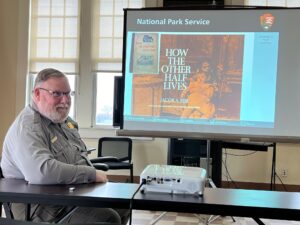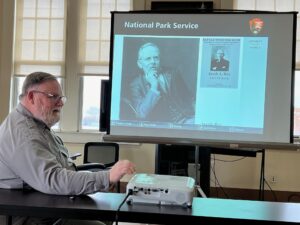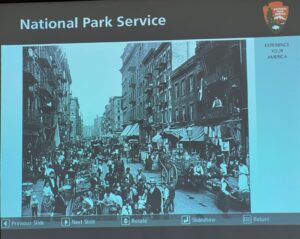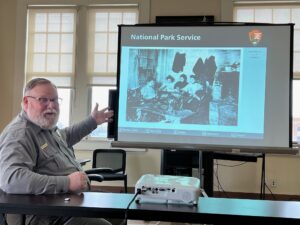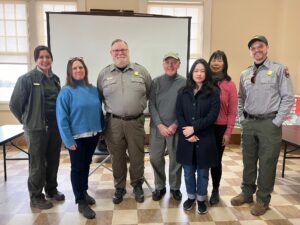On Sunday, February 2nd, visitors convened at the Ryan Visitor Center in Floyd Bennett Field to enjoy a National Park Service (NPS) ranger presentation about the life and career of photojournalist, park advocate and social reformer, Jacob Riis, and how he came to have one of the most visited parks within Gateway National Recreation Area named in his honor.
“‘Most useful citizen’, that’s a heck of a nickname, isn’t it?” said NPS Ranger Lincoln Hallowell of Theodore Roosevelt’s nickname for Jacob Riis, for whom Jacob Riis Park is named.
He said that Riis would write about immigrants and the problems that people were having when he and his family arrived in New York from Denmark in 1849. Riis later worked for the New York Sun as a journalist and eventually bought a house in Richmond Hill, Queens.
Hallowell painted a picture of the immigration experience from the mid- to late-19th century in New York from a historical perspective and through images portrayed in slides of Riis’ photographs.
The photos depicted the squalid living conditions in crowded tenements that accommodated the large influx of immigrants arriving in droves at that time. Many found lodging in places like the basement of a bar, backyard tenement shacks and in free police lodging houses with inhumane and filthy conditions for people who had nowhere else to go; Riis even stayed there for a while when he couldn’t find a job.
Other pictures were of sweatshop workers, suffocating conditions within the tenements where children would work at night on garments brought home from work, children in street gangs and other destitute living conditions in the tenements and on the streets.
“His photos captured the essence of the reality of the times,” Hallowell said.
Riis used the photos in a book he authored, titled, How the Other Half Lives (1890), aimed at upper tier New Yorkers to expose them to the horrendous living conditions of immigrants in the slums of New York.
It got the attention of then Police Commissioner Theodore Roosevelt who went with Riis at night to witness what went on in police lodging houses and in raids on illegal gambling dens to get ideas about how to reform the police department.
Another of Riis’ books, The Battle With the Slum (1902), influenced rich real estate investors and architects to design and build new housing that would include more windows and a shared park in the booming construction era as immigrants spread out across the city.
“One of the things that Riis was quoted as saying was that ‘the children must have a place to play,’” Hallowell said. This led to the construction of Columbus Park in Chinatown, New York and a stretch of beach in Rockaway that became known as Seaside Park in 1914, the year Riis passed away.
In 1932, the Jacob Riis Park Bathing Pavilion was erected by the City of New York for the recreation of its citizens.
“This was one of Riis’ pet projects so that the people of the city would have a place to go where they could get to the ocean, go for a swim, not have to worry about all the tawdriness of Coney Island and actually engage in healthy activity in the summer by the ocean,” Hallowell said.
Today, Jacob Riis Park is a popular beach and recreational destination in the Rockaways in Queens. It is part of the Gateway National Recreational Area, which also encompasses shoreline recreation areas across Brooklyn, Queens, Staten Island and New Jersey.
Visitors thanked Hallowell, who led the History Program at Floyd Bennett Field for 25 years, for the enjoyable and informative presentation.
The Canarsie Courier asked him about future talks and many were surprised to learn from his reply that upcoming presentations might have to be discontinued because he, along with other federal employees, was given a notice by email on January 28th by the U.S. Office of Personnel Management (OPM) under the direction of the Trump Administration that may jeopardize future programming.
The email, posted on the OPM website, asked federal workers to either choose to resign by February 6th and get paid through September or remain under a stringent reformed federal workforce with a focus on merit, performance culture, a streamlined and flexible workforce, and enhanced standards of conduct, leaving many federal employees uncertain about future job security. Hallowell was eligible for retirement but had not planned on retiring at the time of the announcement.
